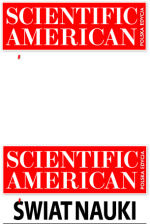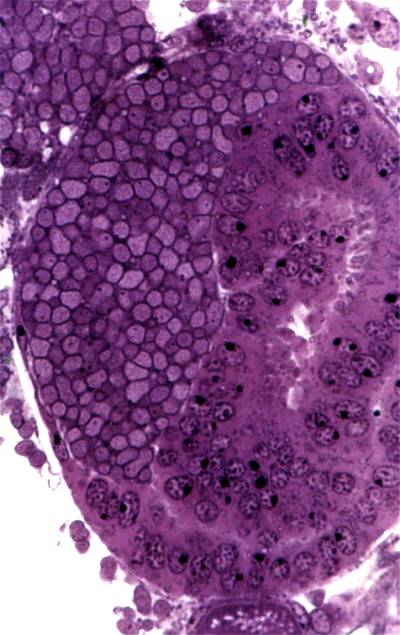 2006
2006
 2008
2008
 2010
2010
 2012
2012
 2014
2014



 |
Dowry full of bacteria
‘Ultrastructure, location and transowarial transmission endosymbiotic microorganisms in aphids (Insekta, Hemiptera: Aphidinea)’
Anna Michalik – author of photograph, Bacteria in the embryo |

|
Description popularizing the research project
Inborn bacterial infection does not mean anything good. It reminds of extreme and gross carelessness of parents, worthless immunological barrier or exceptionally unfortunate accident. The expected result of such an infection can be only one – unavoidable, premature death before reaching next development stage, maybe even before birth. In a more optimistic case, it weakens the organism leaving it to predators and parasites. According to ‘rule of jungle’ that is how evolution eliminates individuals which, in favourable environmental conditions, could produce offspring as unadapted as the generation of parents is.
Yet for aphids, inborn bacterial infections are an indispensible condition to survive. Without the microorganisms, the insect would die of malnutrition. Thanks to the long standing symbiosis with the bacteria, aphids are able to stand a very monotonous diet consisting mainly of water and sugars produced by plants and transported along their shots. The diet, although a high calorie one, is devoid of amino acids necessary to synthesize proteins in tissues of aphids. Bacteria settled in the body cavity of aphids provide necessary amino acids to them. The same menu accompanies aphids from the very beginning of their life. Yet the insects are equipped with colonies of minute symbionts long before they taste the sugary syrup of roses or marigolds. The microbes are with the aphid embryos almost since their conception when they get into the developing ovum. Before the tissues of the tiny insects’ even partition, before they leave their mother’s body, they will have their own micro factories of amino acids.
Females of aphids provide their offspring with a bacterial dowry. In this case, the evolution was cheated. The inborn bacterial infection instead of harm brings benefits to the insects. It seems that the best way to deal with the pests of our gardens is a subcuticle injection with antibiotics.
Abstract
Symbiosis between insects and endosymbiotic microorganisms was described in many hemipterans. The occurrence of endosymbiotic microorganisms in insects that feed on phloem sap is related to their restricted diet. The diet of sup-sucking hemipterans is rich of carbohydrates but deficient in essential amino acids. It is generally acceptable that the major function of the endosymbiotic microorganisms is providing amino acids lacking in phloem sap for their host. The aim of this project was describe to ultrastructure, location and mechanism of transmission of endosymbiotic microorganisms from one generation to the next in advanced aphids Aphidoidea. Studies were conducted using light microscopy and electron one. Results of investigations indicate that in the body cavity of viviparous and oviparous generations of aphids endosymbiotic microorganisms are present. Endosymbiotic bacteria are harbored in large, specialized cells termed bacteriocytes. The bacteriocytes are usually integrated into large organs termed bacteriomes. The latter are localized in the close neighborhood of the ovaries. Analysis of ultrastructure, size and location of endosymbiotic bacteria in aphids indicate that in all the examined species endosymbiotic bacteria Buchnera aphidicola occur. They are spherical in shape and are surrounded by three membranes. Apart from primary endosymbionts in the body cavity of aphids secondary endosymbionts may occur. Endosymbionts are transmitted from one generation to the next transovarially. In viviparous generations of aphids, bacteria infest a young embryo. The bacteria enter the embryo and invade the bacteriocyte cytoplasm. In a young embryo bacteria are located in the posterior pole of the embryo. In oviparous generation, bacteria invade the late vitellogenic oocytes. At the first stage of migration, bacteriocytes with bacteria are located close to the posterior pole of the terminal oocyte. Next, the endosymbionts leave the bacteriocytes and migrate into the oocyte between neighboring follicular cells or transverse their cytoplasm. Then they gather in the cytoplasm of the posterior pole of the oocyte, where they form characteristic “symbiont ball”.
Patronat honorowy
Leszek Jodliński
Dyrektor Muzeum Śląskiego w Katowicach
Zygmunt Łukaszczyk
Wojewoda Śląski
Jan Malicki
Biblioteka Śląska
Piotr Uszok
Prezydent Katowic
Adam Matusiewicz
Marszałek Województwa Śląskiego














